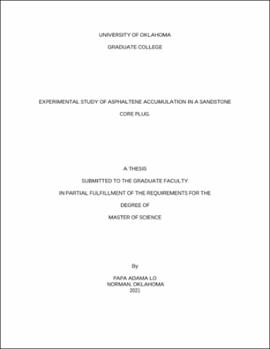Experimental study of asphaltene accumulation in a sandstone core plug
Abstract
Hydrocarbon production leads to the disturbance of several thermodynamic equilibriums including the destabilization of crude oil. Asphaltenes precipitation, aggregation and deposition inside the hydrocarbon reservoirs remains challenging issue due to the multiple factors controlling these processes. Despite the fact formation damage due to asphaltenes accumulation could be highly detrimental to production and/or injection operations, there is no experimental data on asphaltene accumulation during gas and oil flow at high pressure in porous media.
To address this lack of experimental data, we have designed and assembled an experimental apparatus that can be used to study the asphaltene accumulation in porous media during oil and gas flow. We have used this apparatus to investigate the impact of pressure and flowrate on the asphaltene deposition process in a Berea sandstone core plug. Moreover, we also evaluated the efficacy of surfactant injection to prevent asphaltene accumulation within the core plug.
The impacts of pressure were evaluated by injecting simultaneously crude oil and a mixture of 72% of methane and 28% of ethane at pressures of 4,500 psi (1.07%of MMP), 3,570 psi and 3,150 psi at a constant flowrate of 0.025 ml/min and temperature of 170°F. This co-injection of crude oil and the gas mixture was also conducted at flowrate of 0.25 ml/min to evaluate the impact of flowrate. To evaluate the use of surfactant to prevent asphaltenes accumulation, the co-injection of oil and gas was conducted by saturating the core sample with brine containing surfactants (1gpt and 10 gpt) before the establishment of Swir. After core flooding to establish Swir, co-injections of oil and the gas mixture were conducted 300 psi above the MMP at precisely 4,500 psi.
Our experiments show that the permeability loss due to asphaltenes accumulation is more severe as the injection pressure approaches the MMP value. At pressures lower than the MMP, a process of accumulation and re-solubilization is observed. We also observed that an increase of flowrate from 0.025 ml/min to 0.25 ml/min prevents the deposition of asphaltenes, indicating that formation damage by asphaltenes is a slow process that can be prevented by increasing injection or production rates. The injection of surfactants did not prevent asphaltenes accumulation. With the 10 gpt surfactant solution, we observed an occurrence of formation damage earlier than in the cases where the sample was initially saturated with the 1 gpt solution and with brine.
Collections
- OU - Theses [2217]
